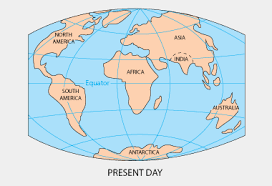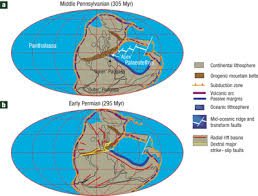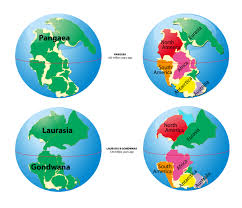Pangaea History and Earth’s Geological Evolution
Pangaea History Pangaea History1. Introduction to Pangaea History
Pangaea History is central to understanding Earth’s past. This supercontinent existed during the late Paleozoic and early Mesozoic eras, uniting nearly all landmasses into one vast block.
The study of Pangaea History allows scientists to trace how continents shifted, collided, and separated over millions of years.
By analyzing fossils, rocks, and tectonic activity, researchers have pieced together the complex puzzle of Earth’s dynamic surface.
2. The Origin of Pangaea

Pangaea formed about 335 million years ago when smaller continents merged. This event was driven by plate tectonics and seafloor spreading.
Its creation was not a sudden occurrence but the result of gradual continental drift spanning millions of years.
The origin of Pangaea History reflects the deep geological processes that continuously shape our planet.
3. Evidence Supporting Pangaea History
Multiple forms of evidence confirm Pangaea History. Identical fossils of plants and animals appear on continents now separated by oceans.
Mountain ranges and rock formations on different continents align perfectly when reconstructed.
This consistency across geology, paleontology, and climatology strengthens the theory of Pangaea.
4. Alfred Wegener and Continental Drift

The concept of Pangaea History gained recognition thanks to Alfred Wegener. In 1912, he proposed continental drift, suggesting continents once formed a single landmass.
Although initially dismissed, his theory laid the groundwork for modern plate tectonics.
Wegener’s vision of Pangaea History revolutionized geology, despite skepticism during his lifetime.
5. Geological Records of Pangaea
Rocks and sediments preserve Pangaea History. Similar layers found on different continents indicate shared geological origins.
These records provide a chronological map of how the supercontinent evolved.
Geological continuity across vast distances highlights the interconnectedness of Earth’s crust.
6. Fossil Evidence Across Continents
Fossils are critical to Pangaea History. The same species of reptiles and plants, such as Mesosaurus and Glossopteris, are found on continents now oceans apart.
This distribution makes sense only if these continents were once joined.
Such paleontological clues make Pangaea History undeniable.
7. Climate Clues from Pangaea

Ancient climate evidence also supports Pangaea History. Glacial deposits in present-day warm regions reveal that they were once near the poles.
Conversely, coal beds found in cold regions suggest past tropical environments.
This alignment of climate records demonstrates the shifting nature of Earth’s landmasses.
8. The Supercontinent Cycle
Pangaea History fits into the supercontinent cycle, where landmasses merge and break apart repeatedly.
Before Pangaea, supercontinents like Rodinia and Gondwana existed. After Pangaea, continents drifted into their modern positions.
This cycle shows Earth’s surface is constantly evolving.
9. Pangaea’s Impact on Biodiversity
Pangaea History influenced biodiversity dramatically. The unification of continents allowed species to spread widely.
However, the vast interior of Pangaea was arid, limiting some ecosystems.
The eventual breakup of the supercontinent spurred new evolutionary pathways and diversification.
10. The Formation of Mountain Ranges
Collisions that formed Pangaea created massive mountain ranges. The Appalachian Mountains and parts of the Urals trace their origins to this event.
These mountains are geological monuments to Pangaea History.
Their structures continue to provide insights into ancient tectonic activity.
11. The Breakup of Pangaea
Pangaea began to split about 175 million years ago during the Jurassic period.
The breakup was driven by mantle convection and seafloor spreading, leading to the formation of the Atlantic Ocean.
This fragmentation is one of the most studied aspects of Pangaea History.
12. Seafloor Spreading and Pangaea
Seafloor spreading was crucial in breaking apart Pangaea. New crust pushed continents away from each other, expanding ocean basins.
Magnetic evidence on the seafloor confirms this process.
Thus, the breakup of Pangaea History is tied directly to modern tectonic theory.
13. Pangaea and Plate Tectonics
Plate tectonics provides the framework for Pangaea History. It explains both the supercontinent’s assembly and disassembly.
Continents ride atop shifting plates, colliding and separating through geologic time.
Without plate tectonics, Pangaea History would remain an unsolved mystery.
14. Ocean Formation After Pangaea
The breakup of Pangaea created new oceans, including the Atlantic and Indian Oceans.
As rifts widened, seawater filled the gaps, forming vast marine environments.
These oceans shaped global climate and ecosystems for millions of years.
15. Pangaea and Earthquakes
The tectonic activity associated with Pangaea History produced significant seismic activity.
Collisions and rifts generated earthquakes that reshaped landscapes.
Today, remnants of these faults still influence seismic patterns.
16. Volcanic Activity During Pangaea
Volcanism was intense during the assembly and breakup of Pangaea History. Lava flows covered large areas, leaving basaltic plateaus.
This activity altered atmospheric composition, releasing gases that impacted climate and life.
Studying these volcanic records gives insight into how Earth’s interior influenced Pangaea.
17. Rift Valleys in Pangaea
Rift valleys mark the beginning of continental separation in Pangaea History. These elongated depressions formed where tectonic plates pulled apart.
Examples of ancient rift systems still exist in today’s continents, serving as evidence of Pangaea’s fragmentation.
The study of rifts reveals the mechanics behind continental breakup.
18. Pangaea and the Atlantic Ocean
The Atlantic Ocean’s origin is tied directly to the breakup of Pangaea History. As the landmass split, new oceanic crust formed.
Magnetic striping along the seafloor proves this gradual widening process.
Thus, the Atlantic Ocean stands as a legacy of Pangaea’s disassembly.
19. The Role of Mantle Convection
Mantle convection drove the motion of tectonic plates, controlling Pangaea History. Heat from Earth’s core caused currents that shifted continents.
This constant movement eventually fractured the supercontinent.
Understanding mantle convection is vital to reconstructing Pangaea’s past.
20. Ocean Currents After Breakup
The breakup of Pangaea History reshaped global ocean currents. New circulation patterns altered climate zones worldwide.
Warm and cold currents influenced biodiversity and weather systems.
These changes underline the impact of continental drift on Earth’s climate system.
21. Pangaea and the Evolution of Dinosaurs
During Pangaea History, dinosaurs roamed freely across the connected landmass. This allowed for wide dispersal of early species.
As the supercontinent split, isolated populations evolved uniquely.
This process contributed to the diversity of dinosaur lineages.
22. Flora of Pangaea
Plants adapted to diverse environments across Pangaea History. Glossopteris forests dominated the southern regions.
Vast deserts spread across the interior, shaping plant distribution.
Fossilized plants provide critical clues about ecosystems in the supercontinent.
23. Fauna of Pangaea
Animal life during Pangaea History reflected both abundance and limitation. Wide-ranging reptiles and amphibians thrived in connected ecosystems.
However, harsh arid zones restricted biodiversity in interior regions.
The fossil record paints a vivid picture of Pangaea’s animal life.
24. Mass Extinction and Pangaea
The Permian-Triassic extinction occurred during Pangaea History. This event wiped out about 90% of species.
Volcanism and climate change linked to the supercontinent may have contributed.
This extinction reset the evolutionary stage for the Mesozoic era.
25. Climate Extremes in Pangaea
Pangaea History reveals dramatic climate extremes. The supercontinent’s size created vast deserts and intense monsoons.
Coastal regions, however, enjoyed milder climates with abundant rainfall.
These contrasts shaped the evolutionary path of organisms.
26. Oxygen Levels During Pangaea
Atmospheric oxygen levels fluctuated during Pangaea History. Declines in oxygen affected both plants and animals.
Some species adapted to lower oxygen concentrations, while others perished.
This variation influenced biodiversity patterns during the era.
27. Glaciations in Pangaea
Glacial deposits reveal that ice sheets existed during Pangaea History. Evidence in southern continents confirms widespread glaciation.
These ice movements shaped landscapes and influenced sea levels.
Glaciations also provide insights into Earth’s shifting climate system.
28. Pangaea and Desert Formation
The interior of Pangaea History was largely desert. Distance from oceans prevented sufficient rainfall.
Sandstone deposits and dune structures confirm these dry conditions.
These arid zones challenged species survival and limited plant growth.
29. Monsoons of Pangaea
Pangaea’s immense size generated powerful monsoon systems. Seasonal winds brought heavy rains to coastal zones.
These cycles supported lush vegetation and thriving ecosystems.
Monsoon evidence is preserved in sedimentary rock layers.
30. Pangaea and Ocean Life
The breakup of Pangaea affected marine ecosystems. New seas and coastlines expanded habitats for marine life.
Species diversified as oceans widened and currents shifted.
Marine fossils illustrate these evolutionary transitions.
31. The Influence of Pangaea on Human Knowledge
Although humans appeared much later, Pangaea influences our scientific understanding. The discovery of the supercontinent concept reshaped geology.
It connected multiple sciences, from paleontology to climatology.
Today, Pangaea remains a cornerstone in Earth science education.
32. Pangaea and the Concept of Deep Time
Studying Pangaea emphasizes the immensity of geological time. Millions of years were required for its formation and breakup.
This deep timescale challenges human perception of history.
It highlights Earth’s constant but slow transformation.
33. Legacy of Pangaea in Today’s Continents
Modern continents carry geological scars of Pangaea. Mountain chains, rift valleys, and rock records remain.
These remnants testify to the supercontinent’s existence.
Every continent today owes its position to Pangaea’s fragmentation.
34. Continental Drift After Pangaea
After Pangaea, continents continued to drift into present positions. The Atlantic widened, and India collided with Asia.
These movements shaped today’s geography.
Continental drift continues as a direct outcome of Pangaea’s breakup.
35. The Indian Plate and Himalayas
The Indian plate’s collision with Asia is tied to Pangaea. As Pangaea broke, India moved northward rapidly.
Its impact with Asia uplifted the Himalayas, Earth’s tallest mountains.
This event illustrates long-term consequences of continental drift.
36. Gondwana and Laurasia
After Pangaea, the landmass split into Gondwana and Laurasia. These supercontinents were stepping stones to today’s continents.
Gondwana contained Africa, South America, Antarctica, India, and Australia.
Laurasia contained North America, Europe, and Asia.
37. Oceanic Evidence of Pangaea
The ocean floor holds records of Pangaea. Magnetic striping, seafloor ages, and spreading ridges confirm its breakup.
Marine geology reinforces plate tectonic theory.
The ocean basins serve as a living record of Pangaea’s demise.
38. The Importance of Paleomagnetism
Paleomagnetism supports Pangaea by recording ancient magnetic fields. Rocks preserve directions of Earth’s magnetic poles.
Matching patterns across continents confirm they were once connected.
This evidence unites geology and physics in studying continental drift.
39. Pangaea in Popular Science
Pangaea has entered popular culture through books, films, and documentaries.
It captures the imagination of people curious about Earth’s past.
This wide interest ensures Pangaea remains a public fascination.
40. Theoretical Reconstructions of Pangaea
Geologists use computer models to reconstruct Pangaea. These reconstructions align continents with fossil and geological evidence.
Such visualizations help illustrate the supercontinent to students and scientists.
They also inspire debates about small-scale details of past geography.
41. Ancient Rivers of Pangaea
River systems flowed across Pangaea, shaping its landscapes. Ancient riverbeds reveal sediment transport patterns.
These waterways supported both plant and animal life.
Fossilized river deposits provide evidence of freshwater ecosystems.
42. Pangaea and Modern Science Education
Schools and universities teach Pangaea as part of Earth science curricula.
It provides an accessible way to introduce plate tectonics.
Students learn about fossils, geology, and climate through Pangaea.
43. Comparing Pangaea to Modern Earth
Pangaea highlights differences between then and now. Today’s continents are smaller and separated by oceans.
Global biodiversity is higher due to isolation and varied climates.
This comparison shows the importance of continental configuration.
44. Pangaea and Mass Volcanism
Large igneous provinces are linked to Pangaea. Massive lava flows, such as the Siberian Traps, coincided with its timeline.
These events contributed to mass extinctions.
The study of volcanic provinces connects mantle processes to surface life.
45. Sedimentary Rocks of Pangaea
Sedimentary rocks preserve valuable records of Pangaea. Layers show shifting environments, from deserts to rivers.
These rocks hold fossils and climate data.
Sediments allow geologists to reconstruct past landscapes.
46. The Role of Supercontinents in Earth’s Future
Pangaea suggests Earth will form another supercontinent in the future. Continents continue drifting today.
Some scientists predict “Pangaea Proxima” in 200–300 million years.
This illustrates the cyclical nature of Earth’s geology.
47. Lessons from Pangaea for Climate Change
Pangaea provides lessons about climate change. Continental configurations altered weather and ecosystems dramatically.
Studying these changes helps scientists predict future climate responses.
Earth’s past offers a window into environmental resilience.
48. Fossilized Forests of Pangaea
Ancient forests thrived across Pangaea. Fossilized wood and leaves are found across multiple continents.
These forests shaped atmospheric oxygen and carbon levels.
They highlight the interplay between vegetation and climate.
49. Earthquakes in Ancient Pangaea
Faults and fractures reveal seismic activity during Pangaea. Earthquakes reshaped landscapes during rifting.
These events left scars still visible today.
Geologists trace ancient fault lines to study past tectonics.
50. The End of Pangaea
The final stages of Pangaea occurred in the Cretaceous period. By then, continents had largely drifted apart.
Oceans widened, and ecosystems diversified.
The end of Pangaea marked the beginning of Earth’s modern arrangement.
51. Pangaea and Continental Resources
Resources like coal, oil, and minerals trace their origins to Pangaea. Continental collision and sedimentation created valuable deposits.
These resources continue to fuel human civilization.
Pangaea’s legacy extends to today’s global economy.
52. The Tethys Ocean and Pangaea
The Tethys Ocean existed during Pangaea, separating Gondwana and Laurasia.
Its closure led to collisions that built mountain ranges.
The Tethys Ocean remains important in paleogeographic reconstructions.
53. Paleogeography of Pangaea
Maps of Pangaea show shifting coastlines and land connections.
Paleogeography combines fossils, geology, and models to rebuild ancient Earth.
These reconstructions demonstrate science’s ability to explore the distant past.
54. Supercontinent Hypotheses Before Pangaea
Before Pangaea History, geologists hypothesized earlier supercontinents. Rodinia and Columbia preceded it by hundreds of millions of years.
These earlier landmasses reveal Earth’s repeating cycles.
Supercontinent hypotheses enrich our understanding of planetary history.
55. The Influence of Pangaea on Modern Biodiversity
Modern species distributions trace roots to Pangaea. Continental separations created isolated evolutionary branches.
For example, marsupials in Australia evolved after isolation.
Biodiversity patterns today are shaped by the supercontinent’s legacy.
56. The Role of Water in Pangaea
Water systems influenced ecosystems in Pangaea. Lakes and rivers provided freshwater for species survival.
Marine incursions shaped coastal habitats.
These aquatic environments played a critical role in supporting life.
57. Cultural Interpretations of Pangaea
Beyond science, Pangaea inspires cultural interpretations. It symbolizes unity and interconnectedness.
Writers, artists, and educators use it as a metaphor.
Pangaea serves as both a geological and cultural concept.
58. Future Research on Pangaea
Future studies of Pangaea will refine models of continental drift. New technologies such as satellite imaging aid reconstructions.
Drilling into deep rock layers may uncover fresh evidence.
Research continues to evolve, expanding our understanding.
59. Challenges in Studying Pangaea
Pangaea is complex to study because evidence is fragmented. Erosion, tectonics, and time destroy many records.
Scientists must piece together incomplete data.
Despite challenges, evidence remains overwhelmingly supportive.
60. Conclusion: The Legacy of Pangaea History
Pangaea reveals the dynamic, ever-changing face of Earth. Its formation and breakup shaped geology, climate, and life.
Modern science continues to uncover lessons from this ancient supercontinent.
The legacy of Pangaea endures as a key chapter in Earth’s story.

